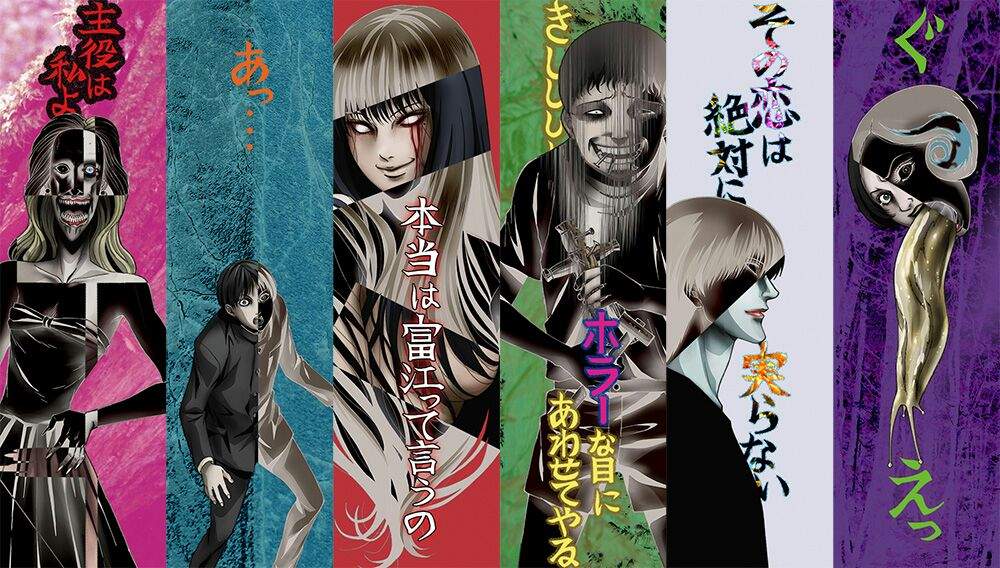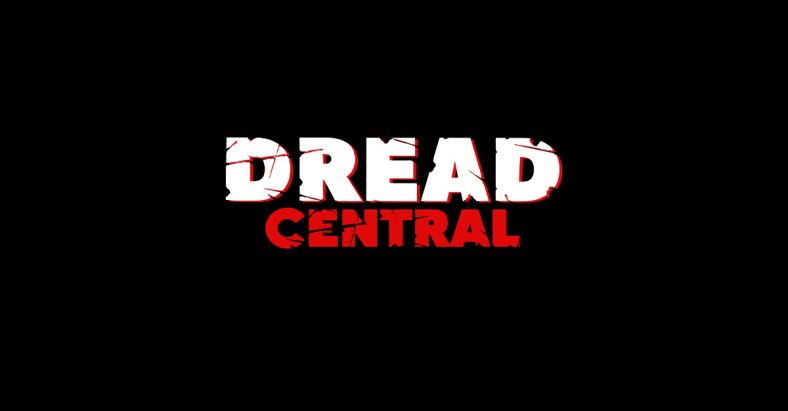 |
| From https://pm1.narvii.com/6695/ a6eaeafd6acef60657dd093b81b39a10eb6e535a_hq.jpg |
Director: Shinobu Tagashira
Screenplay: Kaoru Sawada
Based on the manga of Junji Ito
Voice Cast: Hikaru Midorikawa as
Handsome Man at the Crossroads, Hiro Shimono as Oshikiri, Kaori Nazuka as Yūko,
Mami Koyama as Fuchi, Rie Suegara as Tomie, Yuji Mitsuya as Souichi Tsujii
Viewed in Japanese with English Subtitles
Synopsis: An anthology that adapts stories from the legendary manga
author Junji Ito.
I had been prepared that the Junji Ito Collection, after the initial
excitement running up to its January 2018 premier from Junji Ito fans like myself, that enthusiasm had started to drain
away, finishing with a lot of disappointed viewers, one YouTube video describing how bad the series is compared to Ito's original manga, and a general air
of this being one of the biggest failures of 2018 for anime. I don't think this
adaptation is the worst it could've been. I will agree with this series'
detractors that, production wise, Studio
Deen dropped the ball horribly in visually depicting the legendary horror
author's work, but even in this state, Junji
Ito's work is too good to prevent this anthology from being entertaining.
As a fan of even schlocky anime horror, as long as it's actually horror and not
an action story with monsters, I have a high patience with this type of episode
tale, my own brand of catnip.
The problem with the Junji Ito Collection is the
presentation, looking like a cheap show and with moments, having collected and
read the source material that's been translated in English, where the drop in
style compared to Ito's original
pages does sting. I think however as much of the issue is that Junji Ito's idiosyncratic style is
incredibly difficult to adapt unless you have the style and budget. It is
neither that all his work is too difficult to adapt. Some of it is as with Gyo (2012), the adaptation of his
robo-fish apocalyptic tale which is trashy and not helped by the look of the
film even as an OVA being closer to a trashy cheaper one of yore amongst its
other issues. In other cases, as with the Junji
Ito Collection adapting more slow burn and less ambitious stories, there
was no excuse for this.
 |
| From https://www.dreadcentral.com/wp-content/uploads/2018/01/Junji-Ito.jpg |
Arguably the only adaptation which has succeeded is the live action adaptation of Uzumaki (2000), because Higuchinsky in spite of not having a proper ending, still compromising the adaptation, he purposely adapted the material into his own style. Ito is an exceptional illustrator as well as a good storyteller of bizarre and freakish events, and unfortunately in terms of adaptation, one of his trademarks is reliant on how detailed he is in his shading and etching of everything from facial expressions to the monstrosities he shows on the page. This is very difficult to animate, even in live action as was the case with Uzumaki, unable on its budget to adapt the truly surreal ending of that novel, and if you are not going to provide good OVA or theatrical level quality of production for an animated adaptation, even a healthy TV anime budget, this is going to be impossible to recreate perfectly especially in a tight schedule.
It also didn't please many that,
whilst the first episode ends on a short minutes long story of a girl turning
into a puppet, it is mainly devoted to a comedic story of Souichi Tsujii, a
creepy boy who knows how to induce curses and hexes on his fellow school students.
He is the character who appears the most in multiple episodes, even over Tomie,
and is a character that hasn't to my knowledge ever been adapted into English
publications, which would make this abrupt beginning in farce a jarring choice
for many expecting the creepy and disturbing material Ito is most well known for. I grew to love Souichi Tsujii - a
character who is lovable even though he is obnoxious and spiteful as much
because he always gets his comeuppance every time he appears, the first story
taken from Souichi's Diary of Curses (1997)
and many others shown in this series belying that Ito has written a lot of
eclectic material over his long career, only really known for us in the West
through Junji Ito's Cat Diary: Yon &
Mu (2009), his autobiographical book on raising cats with his wife, being released.
 |
| From https://asianmoviepulse.com/wp-content/uploads/2018/07/Juniito3.jpg |
The eclectic nature of the Collection helps with the series' major flaws. When a story like Long Dream - where a patient in a hospital feels like his dreams for what can feel like days to eventually years - loses its potency due to the average art style, you are yet introduced to Smashed, a tale where a sacred nectar can only be eaten when not noticed - if you are, it's a grotesque and sickly humorous tale reminiscent to the Monty Python foot from the sky, squishing people like strawberry jam for a reason which is even more perverse when revealed. Two very sombre Ito stories appear here and they are among the best - Gentle Goodbye (available in English in the Shivers collection as Lingering Farewell) is about a family who wishes their recently deceased into copies, a story which stands strong even if seeing it in this animated version raises logic gaps in the plot twist, while Bridge is about an ill advised funeral custom of floating the recently dead under a bridge, emphasising as well Ito's really wide talent for a variety of tones. One story, Used Record, benefits from being able to hear the song on a mysterious record which causes people to go insane to try to possess it; whether the song played is actually appropriately macabre or not, it at least gives a hipster's nightmare actual sound. One other story Greased, which is entirely about the most disgusting ways Ito could talk about grease (natural in the skin or cooking oil) and even made me feel ill in this animated adaptation.
And in spite of everything, you
cannot diminish the perverse imagery of Ito's
work, just softening the blow enough with the production and still hooking a
fan of the author's work like me regardless. Here the [Spoilers] have to be implemented to describe such nightmarish
imagery such as an entire century of family continued through their brains and
foreheads being connected on the next heir, or blood fruit that grows from your
wounds, or the results of trying a growth serum causing a horrible elongation
effect all in the midst of dealing with your doppelganger from another realm...
[Spoilers End] here but that is just
part of the many a horrible yet utterly imaginative thing that Ito could come up
with, all of which is still grotesque even in this anime series. If anything
seeing these stories, new or old material together, Ito never lost his creative juices. In fact, this anthology's one
success is that the variety of Ito's world, from cosmic horror to black humour
with a few morality tales thrown in-between, emphasises both his talent but
also makes this one anthology work with enough different tones to never get
boring. You couldn't when one episode can go from the bizarre episodes to
spring up in a town when a transfer student appears, like every cliché of anime
supernatural high school appearing, but also has a sombre tale of the dead
being idolised by scarecrows.
The fact many of these tales, those available in the West or not in their original manga form, are not the biggest titles in Ito's career is to the Collection's advantage as well. With one exception, which is the character of Tomie, the Junji Ito Collection whilst it could've done with a lot more care in its animation and design is still a very good introduction to Ito in terms of his prolific output. Noticeably each story, always two per episode of varying lengths, is numbered but vary leaving gaps, as if this numbering is actually the real chronological order of when Ito's manga were first published. The choice in tales is enough to encourage some to take an interest in Ito's work, making this as an Ito fan still a good work to have been made. And if anything, at least the music's interesting - the opening title is good but the real standout, in front of end credits which include the figures of both tales of that episode appear together, is a fascinating and memorable little song with math rock rhythms that's wormed itself into my head.
Since it hasn't been brought up,
yes Tomie is one of the stories adapted, once in the main series and with two
of its tales in the OVA thirteenth episode, split into two halves strangely
with the question of, if they were released separately, how much the Japanese
fans were ripped off in terms of money to get those fifteen minute pieces. Tomie was one of the biggest draws in
terms of promotion especially for the Western fans as Tomie is a major work in Junji
Ito's career. It's also one of his best as, what could be initially a deeply
misogynistic story about an evil temptress who eventually drives men to
slaughter her, has a deeply complex side to it about the worst in men who
obsess over her and, yes, usually kill and dismember her, only with the issue
that not only does she come back to life and regenerate, but that dismembered
pieces grow into their own Tomies, multiplying her over the landscape. The
first story of the OVA, the first Ito
ever drew, even takes the story to an entire class male or female being drawn
to evil by their worst emotions. There is a potential controversy that, for an
OVA, how this evil is shown is censored, obscuring what would be the most
horrifying moment in the entire Collection
with a disposal of a body, but there needs to be emphasis that, no matter how
horrifying Ito's work can be and even
gory, he has never been about splatter, not only the implied nature of the
scene (with sound and dialogue) being more horrifying than drawn intestines,
but actually more faithful to his source material as a result. It neither stops
the final half, another Tomie story
but with a reoccurring character, ending the Collection on a high if gruesome note, a head where it shouldn't be
conversing with the doctors involved. That the end theme song is a one-off, a
freakish electronic string piece, fits the spike the ending provides even for
disappointed viewers of the series.
 |
| From https://100wordanime.files.wordpress.com/2018/03/junji10c.jpg?w=648 |
Altogether, I liked the Collection. In spite of the elephant in the room - that Studio Deen should've made a series with a significantly better production style if they were going to adapt Junji Ito - the material is still too rewarding despite this. As much because I lowered my expectations approaching this series, the merits outweigh the anger other fans have shown.

No comments:
Post a Comment